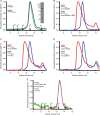Specific disulfide cross-linking to constrict the mobile carrier domain of nonribosomal peptide synthetases
- PMID: 25713404
- PMCID: PMC4502403
- DOI: 10.1093/protein/gzv009
Specific disulfide cross-linking to constrict the mobile carrier domain of nonribosomal peptide synthetases
Abstract
Nonribosomal peptide synthetases are large, multi-domain enzymes that produce peptide molecules with important biological activity such as antibiotic, antiviral, anti-tumor, siderophore and immunosuppressant action. The adenylation (A) domain catalyzes two reactions in the biosynthetic pathway. In the first reaction, it activates the substrate amino acid by adenylation and in the second reaction it transfers the amino acid onto the phosphopantetheine arm of the adjacent peptide carrier protein (PCP) domain. The conformation of the A domain differs significantly depending on which of these two reactions it is catalyzing. Recently, several structures of A-PCP di-domains have been solved using mechanism-based inhibitors to trap the PCP domain in the A domain active site. Here, we present an alternative strategy to stall the A-PCP di-domain, by engineering a disulfide bond between the native amino acid substrate and the A domain. Size exclusion studies showed a significant shift in apparent size when the mutant A-PCP was provided with cross-linking reagents, and this shift was reversible in the presence of high concentrations of reducing agent. The cross-linked protein crystallized readily in several of the conditions screened and the best crystals diffracted to ≈8 Å.
Keywords: crystallization; disulfide cross-link; nonribosomal peptide synthetase; protein engineering; thioesterification.
© The Author 2015. Published by Oxford University Press. All rights reserved. For Permissions, please e-mail: journals.permissions@oup.com.
Figures





Similar articles
-
Structure determination of the functional domain interaction of a chimeric nonribosomal peptide synthetase from a challenging crystal with noncrystallographic translational symmetry.Acta Crystallogr D Biol Crystallogr. 2013 Aug;69(Pt 8):1482-92. doi: 10.1107/S0907444913009372. Epub 2013 Jul 18. Acta Crystallogr D Biol Crystallogr. 2013. PMID: 23897471 Free PMC article.
-
Crystal structure of the termination module of a nonribosomal peptide synthetase.Science. 2008 Aug 1;321(5889):659-63. doi: 10.1126/science.1159850. Epub 2008 Jun 26. Science. 2008. PMID: 18583577
-
Portability of epimerization domain and role of peptidyl carrier protein on epimerization activity in nonribosomal peptide synthetases.Biochemistry. 2001 Dec 25;40(51):15824-34. doi: 10.1021/bi011595t. Biochemistry. 2001. PMID: 11747460
-
[Advances in the study of the mechanism and application of nonribosomal peptide synthetases].Wei Sheng Wu Xue Bao. 2007 Aug;47(4):734-7. Wei Sheng Wu Xue Bao. 2007. PMID: 17944384 Review. Chinese.
-
Exploring the domain structure of modular nonribosomal peptide synthetases.Structure. 2001 Jan 10;9(1):R3-9. doi: 10.1016/s0969-2126(00)00560-8. Structure. 2001. PMID: 11342140 Review.
Cited by
-
δ-(L-α-aminoadipyl)-L-cysteinyl-D-valine synthetase (ACVS): discovery and perspectives.J Ind Microbiol Biotechnol. 2017 May;44(4-5):517-524. doi: 10.1007/s10295-016-1850-7. Epub 2016 Oct 20. J Ind Microbiol Biotechnol. 2017. PMID: 27766439 Review.
-
Acyl Carrier Protein Cyanylation Delivers a Ketoacyl Synthase-Carrier Protein Cross-Link.Biochemistry. 2017 May 23;56(20):2533-2536. doi: 10.1021/acs.biochem.7b00219. Epub 2017 May 8. Biochemistry. 2017. PMID: 28448715 Free PMC article.
-
Colorimetric Assay Reports on Acyl Carrier Protein Interactions.Sci Rep. 2019 Oct 30;9(1):15589. doi: 10.1038/s41598-019-51554-6. Sci Rep. 2019. PMID: 31666546 Free PMC article.
-
Harnessing natural product assembly lines: structure, promiscuity, and engineering.J Ind Microbiol Biotechnol. 2016 Mar;43(2-3):371-87. doi: 10.1007/s10295-015-1704-8. Epub 2015 Nov 2. J Ind Microbiol Biotechnol. 2016. PMID: 26527577 Free PMC article. Review.
-
Probing the structure and function of acyl carrier proteins to unlock the strategic redesign of type II polyketide biosynthetic pathways.J Biol Chem. 2021 Jan-Jun;296:100328. doi: 10.1016/j.jbc.2021.100328. Epub 2021 Jan 23. J Biol Chem. 2021. PMID: 33493513 Free PMC article. Review.
References
-
- Challis G.L., Ravel J., Townsend C.A. (2000) Chem. Biol., 7, 211–224. - PubMed
Publication types
MeSH terms
Substances
Grants and funding
LinkOut - more resources
Full Text Sources
Other Literature Sources

